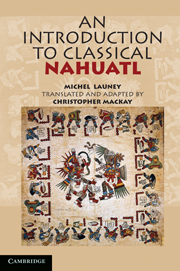Book contents
- Frontmatter
- Contents
- Preface
- How to Use This Book
- PART ONE
- Preliminary Lesson Phonetics and Writing
- Lesson One Intransitive Verbs, Word Order, Absolutive Suffix
- Lesson Two Nouns and Nominal Predicates, the Plural of Nouns, Questions and Negation
- Lesson Three Transitive Verbs
- Lesson Four Emphatic, Interrogative, Demonstrative and Negative Pronouns
- Lesson Five Irregular Verbs, Introduction to Locatives
- Lesson Six Directional and Reflexive Prefixes
- Lesson Seven Quantifiers, Zan, Ye, Oc
- Lesson Eight Preterite Tense
- Lesson Nine Imperative/Optative, Vocative, Future, Imperfect
- Lesson Ten Possessed Forms of the Noun
- Lesson Eleven Inherent Possession, the Suffix -yō, ‘To Have’, Possessive Nouns
- Lesson Twelve Nominal Suffixes, “Adjectives”
- Lesson Thirteen The Principal Locative Suffixes
- Lesson Fourteen Coordination, Phrases of Time and Manner
- Lesson Fifteen Impersonal and Passive Verb Forms
- Review Exercises for Part One
- PART TWO
- Appendix One Traditional Orthography
- Appendix Two The Aztec Calendar
- Appendix Three Inflexional Patterns
- Appendix Four Key to the Exercises
- Nahuatl-to-English Vocabulary
- English-to-Nahuatl Vocabulary
- Index
Preliminary Lesson - Phonetics and Writing
Published online by Cambridge University Press: 05 June 2012
- Frontmatter
- Contents
- Preface
- How to Use This Book
- PART ONE
- Preliminary Lesson Phonetics and Writing
- Lesson One Intransitive Verbs, Word Order, Absolutive Suffix
- Lesson Two Nouns and Nominal Predicates, the Plural of Nouns, Questions and Negation
- Lesson Three Transitive Verbs
- Lesson Four Emphatic, Interrogative, Demonstrative and Negative Pronouns
- Lesson Five Irregular Verbs, Introduction to Locatives
- Lesson Six Directional and Reflexive Prefixes
- Lesson Seven Quantifiers, Zan, Ye, Oc
- Lesson Eight Preterite Tense
- Lesson Nine Imperative/Optative, Vocative, Future, Imperfect
- Lesson Ten Possessed Forms of the Noun
- Lesson Eleven Inherent Possession, the Suffix -yō, ‘To Have’, Possessive Nouns
- Lesson Twelve Nominal Suffixes, “Adjectives”
- Lesson Thirteen The Principal Locative Suffixes
- Lesson Fourteen Coordination, Phrases of Time and Manner
- Lesson Fifteen Impersonal and Passive Verb Forms
- Review Exercises for Part One
- PART TWO
- Appendix One Traditional Orthography
- Appendix Two The Aztec Calendar
- Appendix Three Inflexional Patterns
- Appendix Four Key to the Exercises
- Nahuatl-to-English Vocabulary
- English-to-Nahuatl Vocabulary
- Index
Summary
Since the time of the conquest, Nahuatl has been written by means of the Latin alphabet. There is, therefore, a long tradition to which it is preferable to conform for the most part. Nonetheless, for the following reasons, some words in this book are written in an orthography that differs from the traditional one.
The orthography is, of course, “hispanicized.” To represent the phonetic elements of Nahuatl, the letters or combinations of letters that represent identical or similar sounds in Spanish are used. Hence, there is no problem with the sounds that exist in both languages, not to mention those that are lacking in Nahuatl (b, d, g, r etc.). On the other hand, those that exist in Nahuatl but not in Spanish are found in alternate spellings, or are even altogether ignored. In particular, this is the case with vowel length and (even worse) with the glottal stop (see Table 1.1), which are systematically marked only by two grammarians, Horacio Carochi and Aldama y Guevara, and in a text named Bancroft Dialogues.
This defective character is heightened by a certain fluctuation because the orthography of Nahuatl has never really been fixed. Hence, certain texts represent the vowel /i/ indifferently with i or j, others always represent it with i but extend this spelling to consonantal /y/, that is, to a different phoneme. Most texts represent with -ia, -oa the sequence of sounds that in phonetic terms can be either /-ia/, /-oa/ (two vowels in hiatus) or /-iya/, /-owa/ (vowel, consonant, vowel) etc. Therefore, it is necessary to regularize such writings in the form of an unequivocal notation.
- Type
- Chapter
- Information
- An Introduction to Classical Nahuatl , pp. 3 - 11Publisher: Cambridge University PressPrint publication year: 2011



